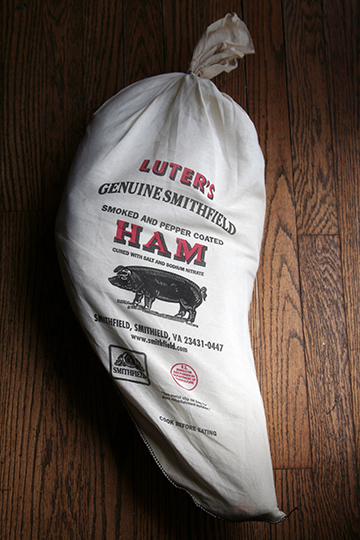Smithfield, Virginia, was founded in 1752. But we must glimpse back to the early 1500s, when a Spanish Explorer by the name of Hernando de Soto first brought hogs to North America, specifically Florida. They were also imported from England and Burmuda by 1639, and this was how they eventually ended up in Jamestown, Virginia. The town of Smithfield, across the James River from Jamestown, was first colonized in 1634, and is now know as “The Ham capital of the world.”
Early settlers needed some way to preserve their meat, and drawing from both the Italians (think Prosciutto) and the Native Americans (who processed salt from seawater and taught them how to smoke meat), they started salt-curing then smoking their hams. As a side note here, we can trace Prosciutto back to China – “Jinhua Ham” is also salt-cured and was brought to Italy by Marco Polo in the 13th century.
These hams quickly became America’s first quality export. Queen Victoria liked them so much she considered them a delicacy. In fact, she had a standing order of 6 Smithfield hams a WEEK!
In 1926, the Virgina General Assembly passed a law dictating that “Genuine Smithfield hams [are those] cut from the carcasses of peanut-fed hogs, raised in the peanut-belt of the State of Virginia or the State of North Carolina, and which are cured, treated, smoked, and processed in the town of Smithfield, in the State of Virginia.” Hogs used to roam the peanut fields and forage for the nuts missed during harvesting. The law was amended in 1966 to enable grain-fed hogs to qualify. An interesting tidbit is that most of the hogs processed in Smithfield come from North Carolina.
Smithfield is also home to the “oldest ham in the world,” and it is on display at the museum there. This ham was producted in 1902, and somehow got misplaced. P.D. Gwaltney, who is credited for refining the process developed by the settlers in 1870, discovered this ham sometime later and wanted to see how long it would last. He called it his “pet ham” and took it with him as he traveled the country to prove that his products would last indefinately without refrigeration. He even insured it by Lloyds of London for $1000, later upping it to $5000, and it has even been featured in “Ripley’s Believe It Or Not.” The ham is now the centerpiece of an exhibit in the Isle of Wight Conuty Museum in Smithfield. In 2006, the museum was flooded by a storm but the ham was saved – Moved and (sorry folks) refrigerated briefly to ensure it would keep. You see, water and Smithfield hams don’t mix (Unless, of course, you are ready to cook!)
